Hip Joint Anatomy
The hip joint is the major weight bearing joint connecting the lower limb and pelvic girdle. It is a very stable joint and has a wide, good range of movements. Only the shoulder allows more movements in the body than the hip. In addition to being flexible, the hip joint also has to support the body weight.
The hip joint is a ball and socket joint and, as the name suggests, is a round and smooth ball (the head of the femur – top end of thigh bone), which rotates in a perfectly matched in size and shape socket (the acetabulum, part of pelvis). (Fig 1)
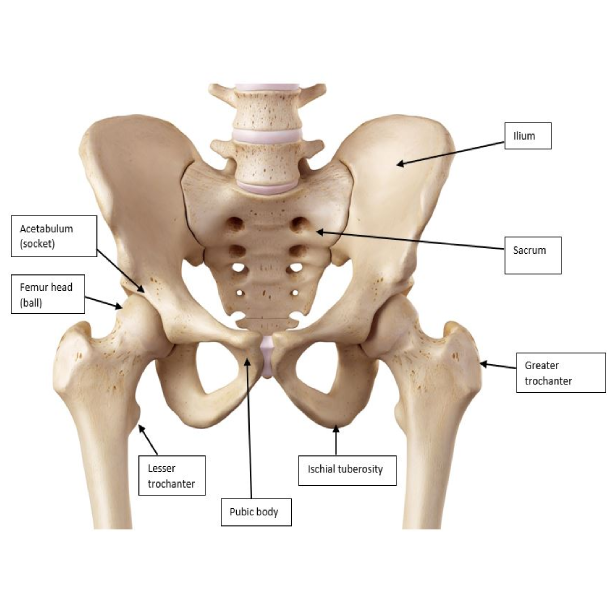
Fig 1
Both surfaces are in contact with each other and are covered by joint cartilage (hyaline cartilage – one of the three types of cartilage in our body) which helps the bones glide over each other smoothly and acts as a shock absorber (Fig 2). They are thicker in main weight bearing areas. Articular cartilage is made up of water (nearly 80%), composites of protein and glucose-based molecules, and scarcely dispersed cells. The body’s ability to regenerate or repair damage to the joint cartilage (hyaline cartilage) is very limited. The capsule covers the joint, and its inner surface is lined with a special membrane called the synovial membrane. Synovial fluid (joint fluid produced by synovial membrane) helps to lubricate the joint and contains nutrients needed to maintain healthy joint cartilage. The acetabulum is additionally surrounded at its margin by the labrum (fibro cartilage – one of the three types of cartilages in our body), which resembles a gasket and helps to stabilize and better lubricate the hip joint. The hip joint is surrounded by strong ligaments and muscles.
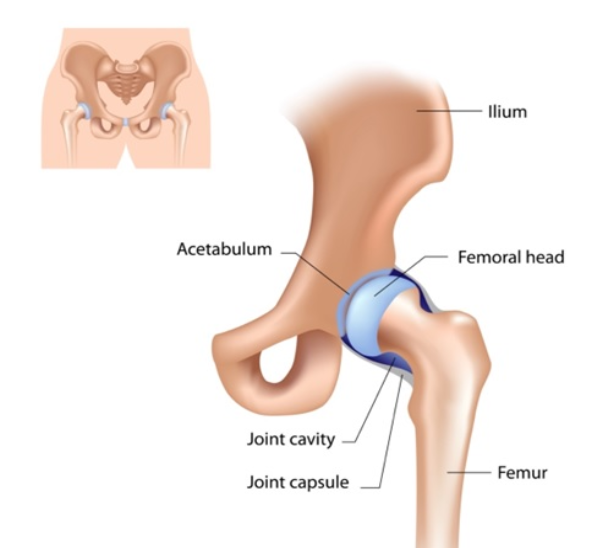
Fig 2

Fig 3
The hip joint is intrinsically stable because of its shape, the labrum and negative suction within the joint. The stability is further significantly enhanced by strong ligaments all around the joint. Strong ligaments merge with the thick capsule and help to stabilize the joint in most directions (Fig 3). Dynamic stability is provided by the large muscles around the joint. These muscles around the hip joint provide the stable and excellent range of movements that we enjoy in a healthy hip joint.
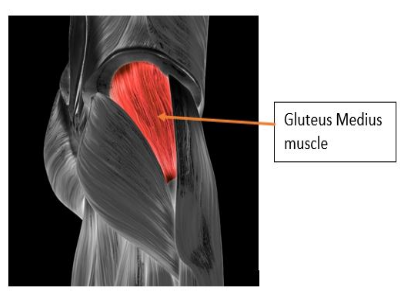
Fig 4
Muscles around the hip joint
The muscles around the hip help propel motion of the hip and pelvis. Some of these muscles also control movement around the spine and knee. They are susceptible to acute or repetitive injury which can result in pain and dysfunction.
Gluteus medius – This muscle is situated at the back and side of the hip (Fig 4). It starts from the outer surface of pelvis (the ilium) and attaches to the greater trochanter. It abducts the hip (moves the thigh outwards), internally rotates the hip, as in turning the foot towards the midline, and balances the body weight when standing on one leg. This muscle is prone to repetitive strain which can present as pain on the outer side of the hip called ‘greater trochanteric pain syndrome’.
Gluteus maximus – This muscle is situated at the back of the hip (Fig 5). It starts from the outer surface of pelvis (the ilium and sacrum) and attaches to the femur and fascia. This is the largest muscle found in the body and helps to extend the hip (moving the thigh backwards) and externally rotate the hip (rotating the foot outwards). Repetitive strain in this muscle rarely occurs.
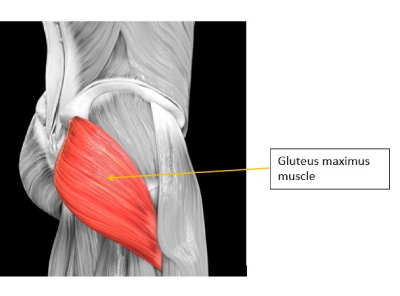
Fig 5

Fig 6
Piriformis – This is a smaller muscle located deeper than the gluteus maximus (Fig 6). It starts from the inner surface of pelvis (sacrum) and attaches to the greater trochanter. It is located close to the sciatic nerve. Repetitive strain to this muscle commonly presents as ‘piriformis syndrome’.
Iliopsoas – This muscle is situated at the front of the hip (Fig 7). It starts from the spine and inner surface of the pelvis (the ilium) and attaches to the lesser trochanter. It flexes the hip and spine and is prone to repetitive strain which presents as pain in the groin and front of the hip.

Fig 7
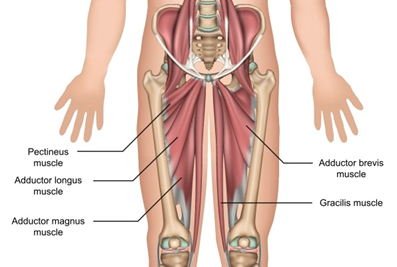
Adductors – are a group of muscles situated on the inner aspect of the thigh (Fig 8). They start from the pelvis (the pubis and ischium region) and attach to the femur. They adduct the hip (move the thigh inwards).
Fig 8
For more details about hip anatomy please follow the following link : https://www.innerbody.com/image/skel15.html
